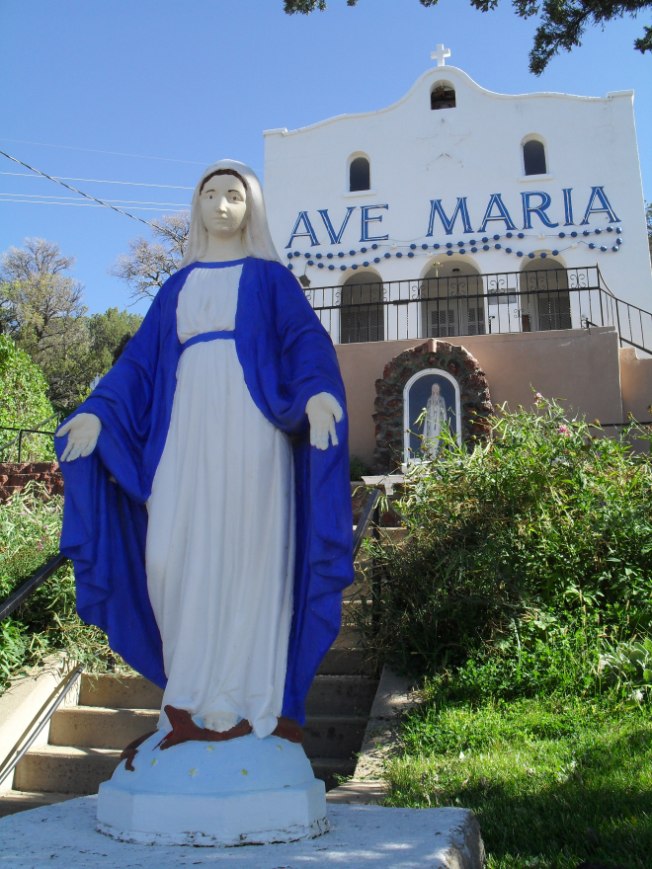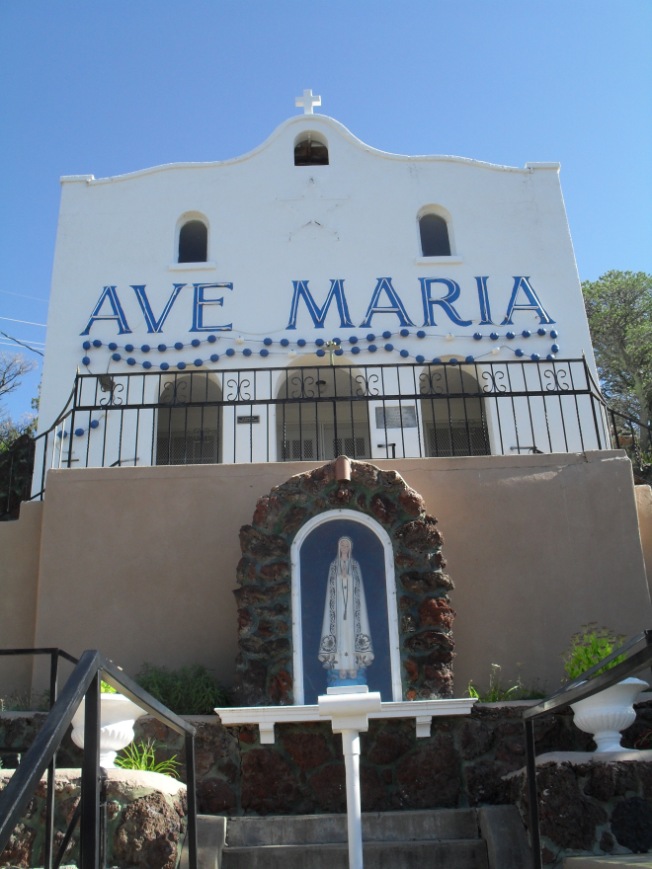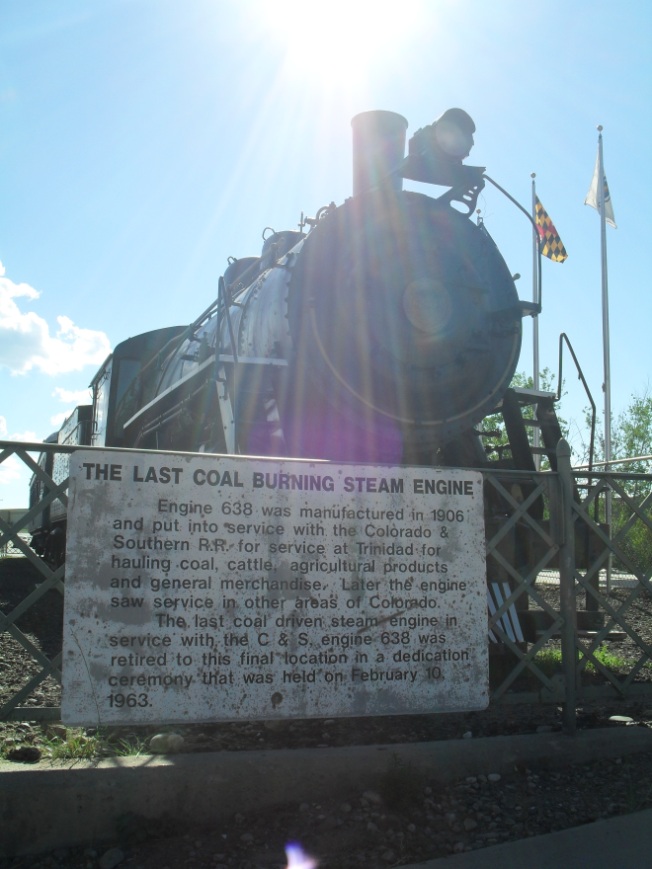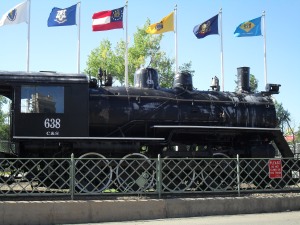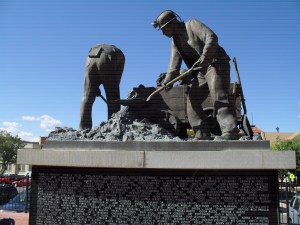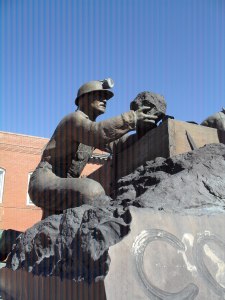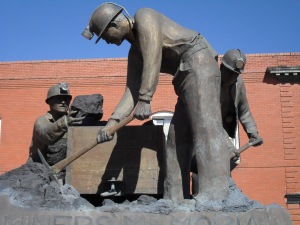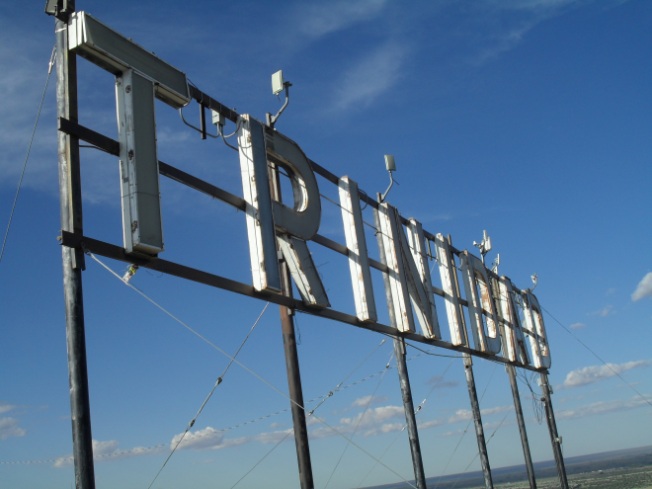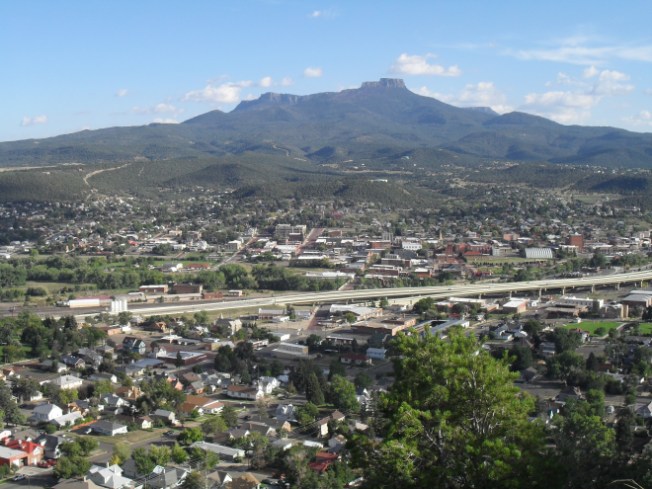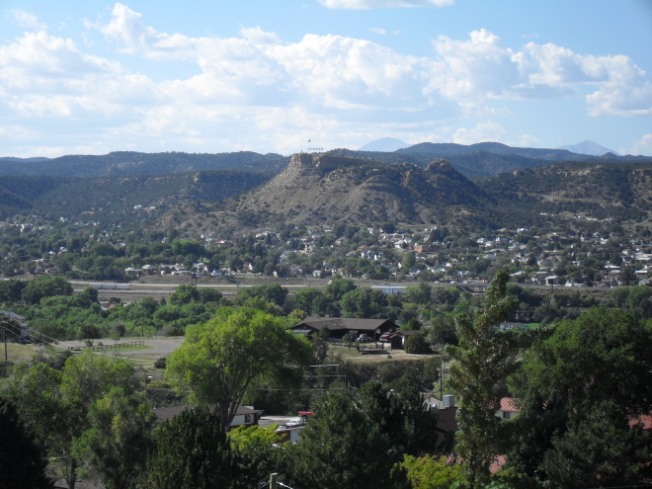When The Poet and I were in communication about the things I wanted to see and do in Las Vegas, I sheepishly admitted I wanted to visit the Gold and Silver Pawn Shop where The History Channel program Pawn Stars is filmed.
I can’t remember when I first watched Pawn Stars. It was probably in some crappy motel room when my then-boyfriend and I were trying to distract ourselves (and each other) from our ridiculous, relentless fighting and our steadily deteriorating relationship. Then, a couple of years ago during a house sitting gig, I watched a Pawn Stars marathon, half-hour episode after half-hour episode all day and into the night. The marathon sealed the deal: I was a Pawn Stars fan.
I enjoy the show’s focus on items of historical significance. Unlike Hardcore Pawn , which I remember focusing on the antics of the wacked-out customers (and not-quite customers), Pawn Stars really does attempt to teach some history. Sure, some of the sellers featured on Pawn Stars are a little zany, but colorful characters do make for good entertainment. And while familial bickering is a subplot of every Pawn Stars episode, it always takes a backseat to trying to educate viewers via the items brought into the store.
When I realized I’d be in Vegas and the Gold and Silver Pawn Shop is in Vegas, I decided I wanted to see it. I was a bit embarrassed to admit this desire to The Poet. First, it seemed like such a stereotypically tourist thing to do. What next? I imagined The Poet wondering. An Elvis impersonator extravaganza, topless showgirls, and all night at the blackjack tables? Also, I didn’t know which side of the TV wars The Poet was on. Some of my friends think all television is soul sucking and mind mushing, while others think a person who doesn’t watch TV is weird. What if The Poet judged me harshly?
I told her in the letter I sent outlining my Las Vegas interests that of course I didn’t expect her and The Activist (her husband) to accompany me on my visit to Gold and Silver. I told her I’d go alone, at some time when they needed a break from being hosts and tour guides. So I was a bit surprised when The Poet told me The Activist wanted to accompany me on the pawn shop visit, unless I needed special alone time there. I assured her I didn’t need to go alone, that I wasn’t on some kind of a pilgrimage. (I’m not that kind of fan.) I told her I’d be happy to have The Activist along.
The day we went to the pawn shop started with a peace vigil.
Every week, members of the Las Vegas peace community hold a vigil in front the Lloyd George Federal Courthouse at 333 Las Vegas Blvd.
…a group of people stand with signs about peace, about the cost of war, asking people to honk in a sign of solidarity if they’re in a vehicle. This particular vigil has been taking place for over ten years. It is very friendly and encouraging.
In warm months, we stand on So. LV Blvd. near Clark. In colder months we stand on So. LV Blvd. near Bridger.
It was a pretty low-key affair the day I attended. About seven of us held signs with various peace slogans on them. The youngest women in the group held the sign that read “Honk for Peace.” She got a lot of honks.
After an hour, the peace group split up and The Activist and I walked The Poet to a coffee shop called The Beat on the corner of 6th and Fremont. In the back of the coffee shop is a large area with art displays and The Las Vegas Zine Library (LVZL). We poked around back there for about half an hour, then The Poet settled in to write while The Activist and I went on our excursion.
We walked down Fremont Street to get to Las Vegas Blvd. Fremont wasn’t very busy since it was a Wednesday morning. I did the tourist thing and took some photos.

And since I was playing tourist, I took some photos of the wedding chapels we passed on the way.


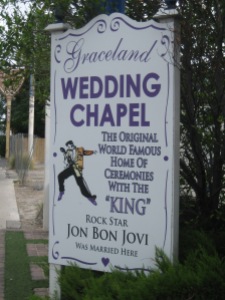
I mean, if getting married in a ceremony with the “KING” is good enough for Rock Star Jon Bon Jovi, it must be good enough for me. (The question is, is Mr. Bon Jovi still married to the lady he wed in the Graceland Chapel?)
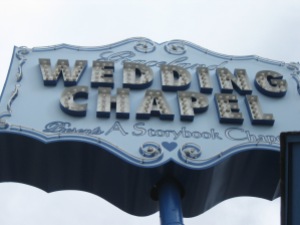
While we walked, The Activist told me he was glad to have a reason to go to Gold and Silver. He said he’d wanted to check it out since he’d moved to Vegas, but none of their other house guests had expressed any interest in visiting the place.
We approached Gold and Silver from the parking lot side. There weren’t many cars parked there, but there were several guys in orange vests monitoring the lot and the people in it. I wondered if they only allow people with items to sell or pawn to park in the lot.
During my preliminary research, I’d read there’s sometimes a line to get into the shop. I was glad to see that on this day there was no line outside and we wouldn’t have to wait to get in.
I’d also read online complaints from people who’d expected to see the actual stars of Pawn Stars–Rick, The Old Man, Corey, and Chumlee–and were disappointed when the guys weren’t in the shop. Give me a break! I’d never expect the stars of a big History Channel program to be standing around to chitchat with the riffraff. Maybe in the earliest days of the show, a visitor might run into one of those guys in the shop, but now? Forget it! Those guys are big shot famous people. They probably only come around for filming and probably stay in the office until the cameras are ready for them. I would have been astounded to see one of the show’s stars hanging around in public.
When The Activist and I approached the entrance, there were three other tourists (a family, perhaps, and by their accents European) blocking the sidewalk while taking photos of each other. Ugh! I don’t like to be the kind of tourist who gets in the way of other people, so I decided I was not going to be taking a lot of photos.
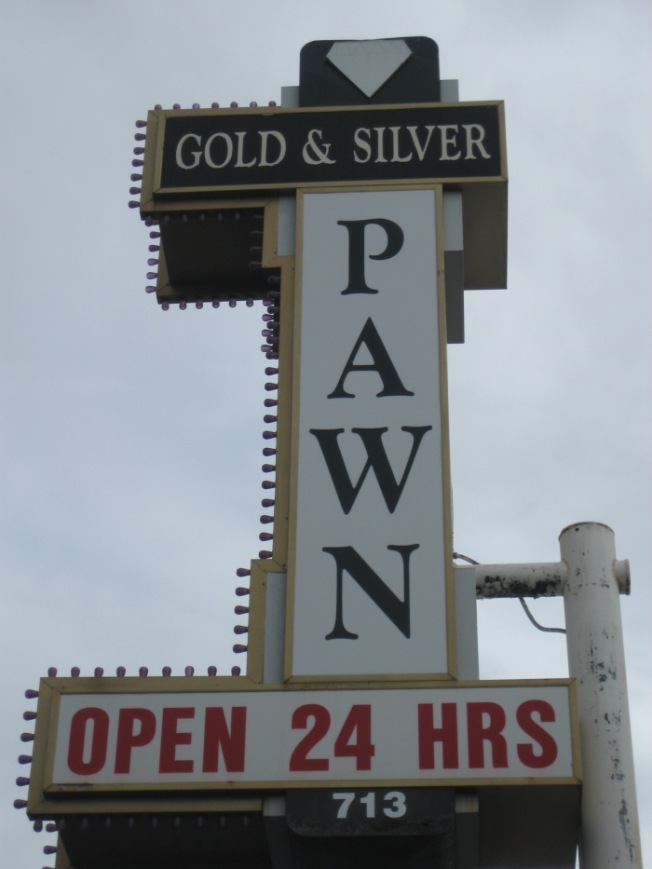
This is my one tourist photo from Gold and Silver Pawn Shop, the outdoor sign in front of the store.
The Activist and I went inside, and I was shocked by how small and…shabby the store looked. On TV, the shop seems spacious and glamorous, but in real life it looked something like a warehouse lit with fluorescent lights, the merchandise on display crammed too closely together.
The first thing The Activist noticed and pointed out to me was a display case full of the same model of Rolex watches. Why were they all the same?
As we made our way through the store, we saw a lot of collectible coins and currency, jewelry, art, items I guess would be referred to as “collectibles.” I didn’t see anything that even mildly piqued my interest, but I’m weird that way.
At the back of the store was a life size cardboard cutout of Rick folks could stand next to for a photo-op. No one was doing that.
One area of the store was filled with Pawn Stars souvenirs. One could buy the book Rick wrote. (Until the moment I saw the book in the store, I had no idea it existed.) One could buy dashboard bobble heads representing the guys on the show. One could buy Pawn Stars magnets and keychains and ink pens. (They almost got me with an ink pen, but I told myself sternly that I did not need one.) There were several Pawn Stars t-shirts to choose from displayed on the wall next to the cash register and its bored-looking cashier. There were even wristbands with the words “Chumlee Is My Homeboy” stamped on them. And then there were postcards.
I love postcards. I probably came to love them when I was in middle school. Whenever my family went on one of our infrequent trips, the first thing I wanted to do was buy postcards. Then I’d spend as much time as possible ignoring my family and writing out postcards to send to my friends back home. Now I look at thrift stores for postcards from places I’ve never been. I send them to friends when I don’t have enough to say for a whole letter.
I wanted to send postcards from Vegas, but I hadn’t seen them for sale anywhere I’d been. I thought if there were Pawn Stars postcards, maybe I’d buy some and give my friends a good laugh about what a tourist I’d been.
When I was a kid, I was thrilled when I’d sometimes find 10 for $1 postcard deals, but those days are long gone. Now 4 for $1 is a good deal for postcards, and 2 for $1 is about normal. (I did buy postcards with local historic scenes on them for $1.50 each when I was in Trinidad, CO, but that was partly because they were the only postcards in town and partly because the guy selling them was my friend’s friend on whom I had a tiny crush.) I know I probably wouldn’t get four Pawn Stars postcards for $1, but I figured 50 cents each would be ok.
I turned the rotating rack until I found the few remaining postcards. They were kind of boring, but they would do. Then I saw the price tag: $2 each!
Are you fucking kidding me?!?
Where do they get off charging two bucks for their postcards? Even when I bought postcards of my own photos from Vistaprint 100 at a time, I only paid 20 cents each. Certainly Pawn Stars gets a better deal than that.
At that point I was over the whole Gold and Silver experience. I’ll continue to watch the show (and try to figure out how the cameras make the store look so big and upscale), but I won’t be giving them any of my money…Greedy bastards…
On the way to lunch, we were stopped in traffic right in front of the driveway to the Bonanza Gift and Souvenir Shops.
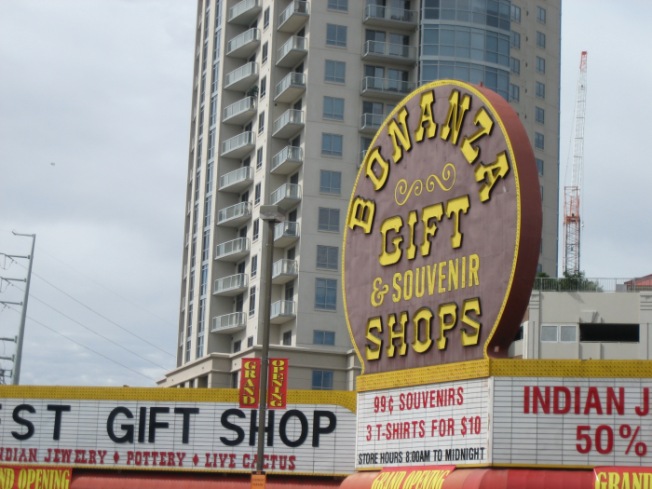
Hey! I called from the backseat. Can we stop here so I can get postcards? I’ll be real quick.
My friends indulged me, and we pulled into the parking lot. I jumped out of the car and went in one of the many doors. Right inside was a rack of postcards. The price? 3 for 99 cents. The price was right for me.
Several of the attractions mentioned in this post are on the Jen Reviews list of 100 Best Things to Do in Las Vegas. Bonanza Gifts is #18.
If you’re going to Las Vegas and have a bigger souvenir budget than I did, check out this Tripedia article about the Top 7 Souvenirs to Buy in Las Vegas. Elvis jumpsuit, anyone?
I took all the photos in this post.


















